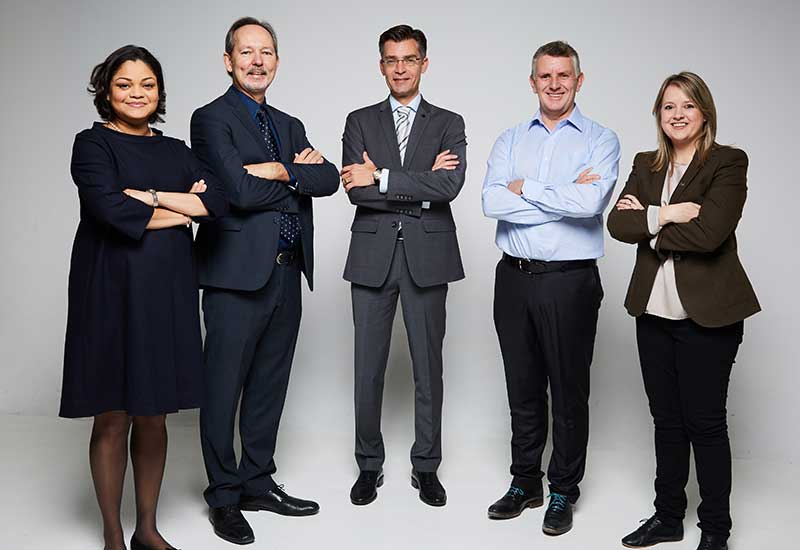 The group of human resources experts gathered together at ITP Media Group on October 31 to discuss pertinent issues.
The group of human resources experts gathered together at ITP Media Group on October 31 to discuss pertinent issues.
Let’s talk training. Tell us more about the programmes that you implement in-house.
David Leman, Marriott International: It’s not as simple as what you do to train people. We have a learning management system that has 4,000 programmes, and there’s something for everybody, at every level, in every position, in every geography. Sometimes it can be too much, so strategically we are working on simplifying this, and we are bringing in three programmes that define our leadership development: Base Camp, which
gets you into managerial positions; Ascent, which gets you into directorship; and Summit, which gets you into executive leadership.
The newer approach is to bring in external companies to train us, which we haven’t typically done. The challenge that we probably have with these programmes is the bandwidth of delivering them. We are 250 hotels, with another couple of hundred due to open in the next few years; that takes our associate headcount in the Middle East and Africa (MEA) to just over 120,000 associates, which is incredibly challenging. I’ve had to expand the learning and development (L&D) team; I have 16 people now, to manage that complexity and volume.
Peter Mitchell, Movenpick Hotels & Resorts: At the end of the day, retention comes back to you, and the value that you get from your job. Most companies have programmes that are hotel-based, plus individual ones. We have what we call ‘area learning forums’ in four areas: Europe, Africa, the Middle East, and Asia. These are regional programmes that are run by certifying trainers from the region, from supervisory to middle management.
You’re looking to grow skills all the way up. From that point, we have Mövenpick Business Academies, where we use external consultants to deliver programmes that are aligned to our culture and our needs. This all leads to making sure that we have got the right people for the future. How do we identify the potential department heads for the number-two roles; how do we identify the number -twos for the number-one roles? And then, do we have general managers to meet our growth needs? Identifying them and then training them is our key priority.
I’d say we are successful with that, because most of our senior managers — I’m going to say 20% to 30% of those — have gone through that programme and are sitting in either GM or number-two roles. This sends a very powerful message: if you have both the skills and the potential, then there’s a path.
Laura Laugier, Kempinski Hotels: For us, it’s really focused on luxury. We focused last year and this year on the junior team members. The middle-management trainers who are training the employees on the job have been our main focus. We have been implementing on-the-job training tools, and for us, as a luxury company, our niche is such that it’s a service. However, leadership is very important, because no matter what you bring in, if your leaders are not on board with it, they will continue to turn over and go.
What we’ve done in 2017 is to go heavily into a lot of assessments of our general managers and hotel managers, and cascade that down to the ExCom next. Based on those assessments, we are implementing leadership training next year, and it’s going to be a bit of a blend between e-learning and classroom learning.
We’re doing it very systemically because we are tackling quite a few things at the same time, including employee engagement, which was a very big topic last year. We have been measuring satisfaction for many years and now we’ve gone into engagement with Gallup. Recently, we received the results for this year and I’m pleased to say that we have improved. We’re not just taking it from the learning aspect, but also from the human resources and engagement side of things as well, to see how we are doing.
Lynne McGarvey, Media One Hotel: We are an independent property, so we have a different perspective, perhaps. This year we have looked at a lot from the recruitment stage. We have a lot of internal growth, which is good to see, but we are also looking at the people that are coming in — what can we offer for them? If we can’t grow them, we know that they might leave quickly. So, we are asking what we need to do for that person, at any level, in the first three months.
For leadership, we are also looking from outside. Managers and the senior team would value an outside opinion. We spend all day together, all year — we need to listen to what people from the outside are telling us. It’s in the recruitment, then on-boarding, then identifying who is the talent and how we can keep them.

| Advertisement |








 Search our database of more than 2,700 industry companies
Search our database of more than 2,700 industry companies









